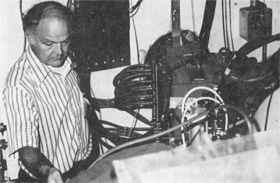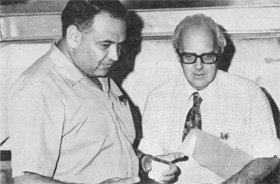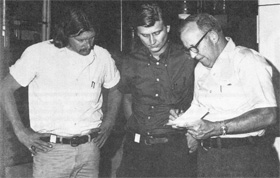First Beam in Cancer Therapy Facility
About 2 a.m. on Thursday, July 17, 1975, the Accelerator Division successfully created the first beam of neutrons for the Fermilab Cancer Therapy Facility (CTF).
The success comes close behind the granting of funds on June 12 by the National Cancer Institute for the operation of the Fermilab CTF for the coming year.
The two milestones bring closer to reality the hope that by the beginning of 1976 the Facility can be used to study the effectiveness of neutron irradiation in the control of certain types of cancer.
Many months of determined effort by Fermilab personnel has led to this opportunity to demonstrate the feasibility of using the Fermilab linear accelerator as both an injector in the accelerator system and as a source of radiation for medical research.
Miguel Awschalom and Don Young have directed the physics effort involved in the Fermilab CTF. They have been aided by a number of other staff people who have frequently volunteered their efforts over and above their regular jobs at the Laboratory.
The present arrangement for an adaptation of a portion of the linac gallery is a metamorphosis from several earlier ideas for applications of the linac for medical purposes. The Illinois chapter of the American Cancer Society also contributed $17,300 to the project last February. The NCI grant covers operational funds. Funds to build the facility must be found elsewhere. High energy physics research funds are not used for this purpose.
The Fermilab linac accelerates protons to 200 MeV for injection into the other accelerators, but only .8/second out of every 6-second cycle of the accelerator operation requires the linac injection. The remaining time the linac beam is available for other use. The neutron beam to be used by the CTF is created by using 67 MeV protons from the linac, carrying them to an adjoining room where they bombard a lithium target, creating neutrons which can then be focused to a tumor site. A neutron is an uncharged, subatomic particle with a mass close to the mass of the proton, the type of particle accelerated at Fermilab. One of the chief advantages of fast neutron beam cancer therapy over conventional x-ray therapy is that the neutron beam does not do as much damage to surrounding healthy tissue.
In order to extract the 67 MeV protons from the linac, tank #5 of the linac was moved seven inches downstream several months ago to permit extraction devices to be installed. In recent months, as the operation schedule permitted, a hole was drilled through the linac shielding wall and other necessary work completed for the new installation. Shielding blocks for the new CTF were acquired from the former Princeton-Penn Accelerator. Software was written and tested in the linac computer
For at least the next five months, the properties of the Fermilab neutron beam will be studied from a medical physics point of view. The size and shape of the beam, the projected dosimetry, as well as biological studies using bacteria, tissue cultures, and small mammals, will be carefully evaluated.
A large group of physicians and radiologists from the Chicago area has worked with Fermilab personnel in planning and designing the CTF. Dr. Lionel Cohen, head of radiology at Michael Reese Hospital in Chicago, serves as head of the Fermilab CTF. If initial tests are successful and work with human patients is authorized, the medical profession is expected to refer patients from all over the United States for treatment at Fermilab. The use of fast neutrons for cancer therapy has been tested with encouraging results at several other institutions in other parts of the world. About 1,000 patients a year could be treated at Fermilab in the new facility. It is planned that no patients will be housed or hospitalized here.
"This has been an effort of many people contributing time and effort in addition to their normal laboratory responsibilities," Don Young reports. "These first achievements in this intensive program, which may ultimately play a vital role in saving lives, are results of those efforts. Although more have contributed than can be mentioned here, all of these efforts are greatly appreciated. We should use this example in our future efforts to achieve the long-range goals of Fermilab."








